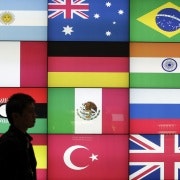The G20 needs strategic leadership
The leaders-level G20 was born at a time of crisis and panic. In early October 2008, when the United States issued the invitation to the G20 heads of state or government to assemble in Washington DC on November 15, the world economy was facing the danger of a total collapse of the financial sector in the United States. Panic is contagious. A financial sector collapse in the largest economy and the financial centre of the world would have brought down with it the entire global economy.
The United States had to act to arrest the collapse and did so by unprecedented intervention in its own banking and insurance sector. This was quickly followed by equally unprecedented fiscal and monetary expansion, and even intervention in the industrial sector. These actions contained the crisis but did not prevent a drift towards worldwide recession.
It was clear that the financial sector virus was spreading and that economic expectations had been shattered worldwide. There was a danger of steep global declines in investment and consumer demand, ensuing mass unemployment and beggar-thy-neighbour protectionist trade policies triggering the kind of vicious deflationary cycle that the world had gone through in the Great Depression of the 1930s. A floor had to be put under expectations, a sense of resolve had to be projected, fiscal expansion had to be encouraged wherever feasible, and protectionist reflexes had to be countered before it was too late.
This is how the leaders-level G20 was born. Previous resistance to including the large emerging countries at the head table, formerly monopolised by the G7, evaporated. China, India, Brazil and others were needed both psychologically and substantively for the response to the crisis be credible. The fact that there already was a Finance Ministers’ level G20, born in the late 1990s after the Asian financial crisis, allowed the US to short-circuit the debate on who should be included.
It is not possible to measure exactly the impact of the first meeting in Washington or the second in London. Most observers agree, however, that the combination of decisive action by the US Federal Reserve and Treasury, the G20 commitment at the Washington meeting not to raise trade barriers, and then the signal at the April 2009 London meeting of broadly concerted fiscal expansion and a green light for tripling the ‘firefighting’ capacity of the IMF, did make a critical contribution to turning around expectations and arresting what was threatening to become a global economic free-fall.
Five years after those first two leaders-level meetings, the questions are whether and how these summits, which have become an informal institution, can really add continuing value to global economic governance.
Firefighting an ongoing crisis no longer dominates the agenda. There has been a slow but steady global recovery, allowing for a gradual normalisation of monetary policy in the United States and reducing the near panic relating to the euro-zone that prevailed in the past half-decade.
This year may witness instability, however, for non-economic reasons, such as the tensions mounting between the United States and Russia and unfolding events in Ukraine or over Iraq. These events may cast a shadow on the G20’s possible achievements: only time will tell.
The main challenge now is to create sustainable world growth based on real investment that stimulates total factor productivity gains and provides new, long-term jobs in the value-added chains of the products and services of the future. Laying the foundations for sustained growth through productivity-enhancing reforms is the right strategy. So too is enabling productive investment in infrastructure.
It is also time to make sure that key global economic institutions are robust and able to withstand unexpected shocks if and when they occur. Leaders can add value, for example, by asking big questions about whether the global trade regime is headed in the right direction, or how to shape the investment regime.
The composition of the G20 itself is an improvement on the G7/8. The inclusion of five more Asian economies in the group (Australia, China, India, Indonesia and South Korea), three Latin American economies (Argentina, Brazil and Mexico), as well as Saudi Arabia and Turkey, was a major step forward. These additions, along with South Africa, deliver regional, cultural and institutional diversity to the high table. Agreement may be more difficult, debates more intense, and disagreements out in the open. In global negotiations, though, it is more important to be talking to those with whom reaching some kind of agreement is difficult rather than just with those among whom there is agreement to begin with.
The proper division of labour is for meetings of finance ministers and central bankers to deal with the technical detail and for G20 leaders to provide strategic guidance on urgent global problems.
There has been some progress on ‘focus’ in the agenda. That will now be key to the centrality and effectiveness of the G20.
By far the biggest challenge for each G20 host is the total engagement that must go into providing leadership of the global economy through and beyond the host year. In 2014 the expectations are high that we will see a turning point from the ‘new normal’ to ‘strategically-directed’ G20 summits and hence a new phase in global governance. The task for Australia in 2014 will be to deliver and sustain an emerging sense of strategic direction.
















